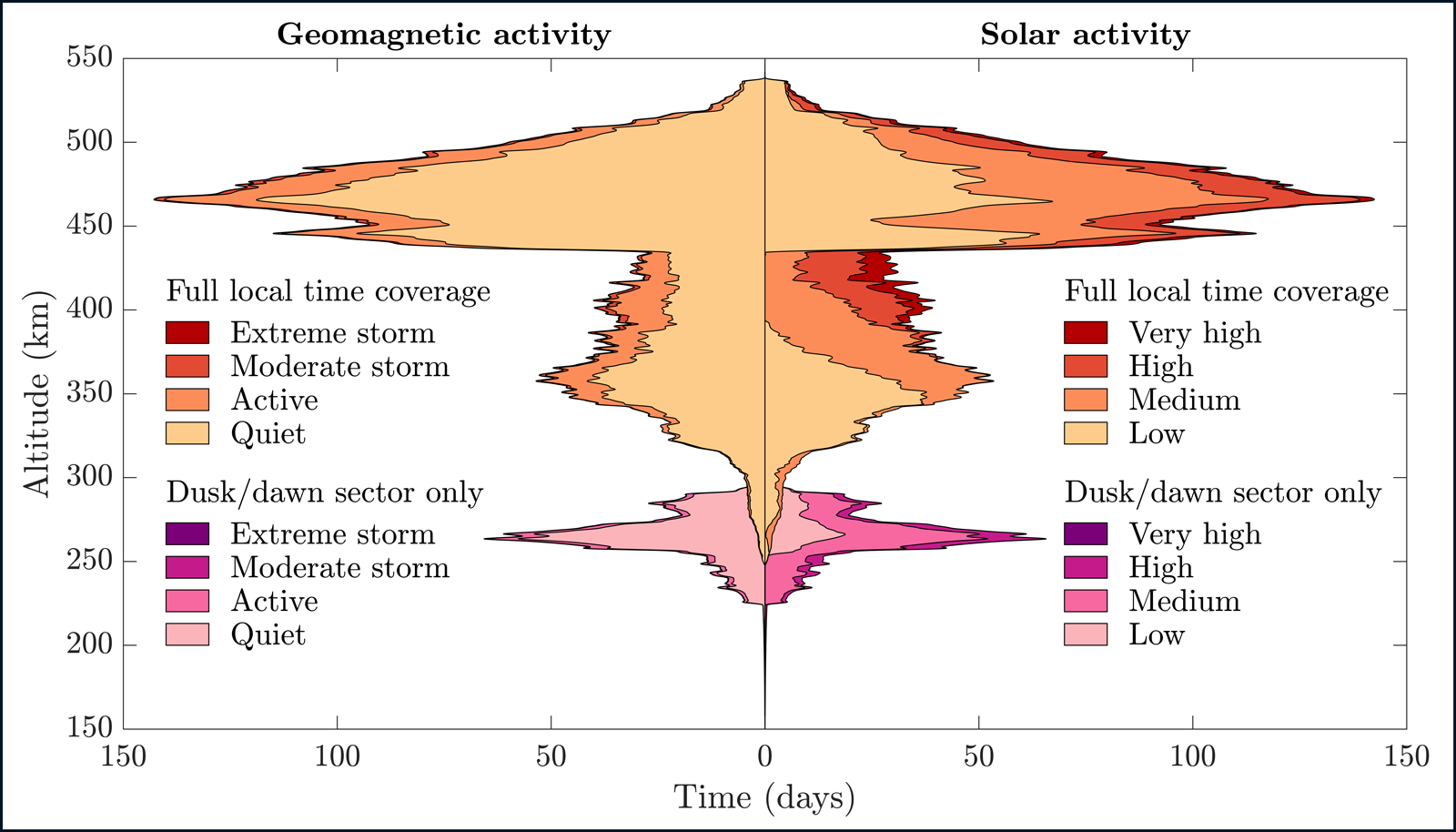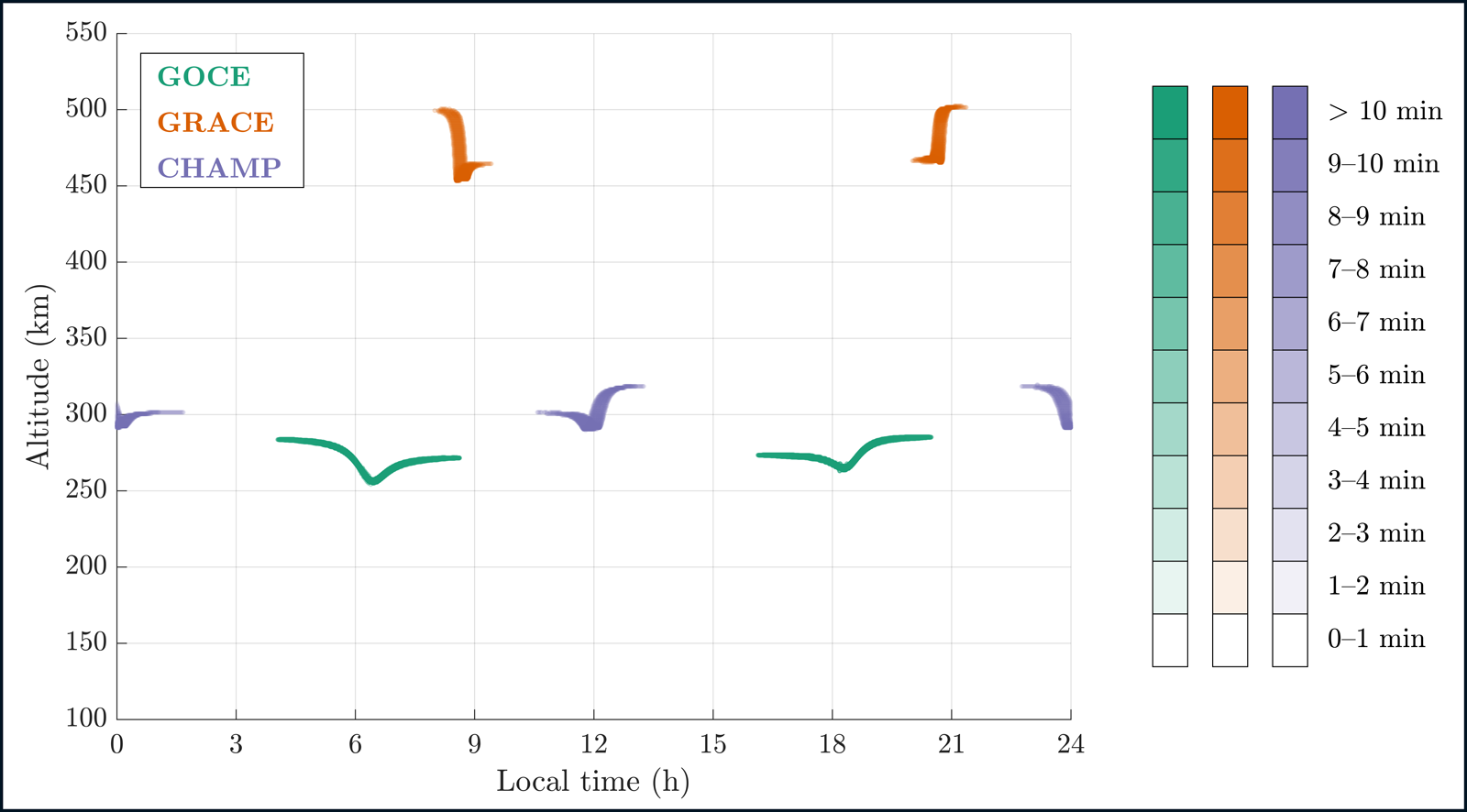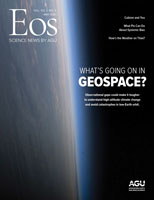Satellites play important roles in our daily lives, providing navigation, data, and communications solutions, as well as Earth observations to monitor weather, climate, and natural resources. All of this information is vital for policymakers, businesses, and consumers. However, increasing demand for the services that satellites provide has also created an increasingly crowded environment in the low–Earth orbit (LEO) region where many of these satellites operate. Unlike automobiles on crowded city streets, satellites lack onboard drivers who can steer around obstacles at a moment’s notice. To avoid collisions and plan evasive maneuvers, satellite operators predict orbits and account for accurately known gravitational forces; they must also account for trajectory changes brought about by atmospheric drag on the craft, a far more difficult task.
The potential addition of tens of thousands of objects to low Earth orbit will escalate the risk of catastrophic, and cascading, collisions.
Approximately 1,800 active satellites currently operate below 1,000 kilometers in altitude [Union of Concerned Scientists, 2005], where air resistance, or drag, is large enough to significantly affect satellite orbital trajectories. These active spacecraft share this region with more than 10,000 inert satellites and pieces of debris.
The construction of very large constellations of commercial LEO satellites began in about 2018 when the private company SpaceX launched its first Starlink satellite prototypes; other companies (e.g., OneWeb, Amazon, Telesat) have followed suit or are preparing their own constellations. Adding to the congestion is a rapidly increasing number of low-cost small satellites, which can now be built using largely off-the-shelf components. The potential addition of tens of thousands of objects to LEO will escalate the risk of catastrophic, and cascading, collisions. The resulting exponential increase in orbital debris could make LEO unviable [Kessler et al., 2010], and crossing to higher orbits could become perilous.
In LEO, atmospheric drag is by far the dominant source of error associated with orbit propagation (numerical modeling to predict a satellite’s future position and velocity), and it plays a defining role in satellite mission planning, orbit and reentry prediction, and collision avoidance. Accurately tracking and predicting the locations of objects in space is of paramount importance to assessing collision risk, which determines whether executing avoidance maneuvers is necessary. Thus, the projected massive increase in the number of orbiting spacecraft in the near future is driving an increasingly critical need for more accurate satellite drag modeling and forecasting.
Quality Models Require Quality Input
The greatest limitation to improving thermosphere models is the inconsistent quality and sparse distribution of upper atmosphere observations.
The accuracy of orbit prediction relies on the quality of the atmospheric drag force models and the forecasts they produce. Satellite characteristics (e.g., size and geometry) influence atmospheric drag, but drag mostly depends on the very low density of the highly variable upper atmosphere, called the thermosphere. Realizing significant advances in orbit prediction will require more accurate specification and forecasting of this space environment. The greatest limitation to improving thermosphere models is the inconsistent quality and sparse distribution of upper atmosphere observations.
Uncertainties in atmospheric drag modeling are largely associated with variability of the density of the neutral (as opposed to charged) atoms and molecules in the thermosphere. This variability is driven by changing solar extreme ultraviolet emissions (referred to as solar activity), by interactions of the magnetosphere with the solar wind (referred to as geomagnetic activity), and by upwardly propagating meteorological perturbations like gravity waves and tides that originate at lower altitudes in Earth’s atmosphere.
Information about these driving sources is required to feed both empirical and physics-based models of the upper atmosphere, which in turn are used (separately) to calculate satellite drag. Despite progress made over the past couple of decades, large uncertainties still exist in estimates of the solar, magnetospheric, and gravity wave energy input to—and thus in how this energy affects—the thermosphere [e.g., Siscoe et al., 2004; Palmroth et al., 2005; Peterson et al., 2012; Oberheide et al., 2015; Becker and Vadas, 2020].
As the scientific community focuses on improving measurements of the magnitude, spatial distribution, and temporal evolution of these drivers, efforts are under way to advance modeling of thermospheric variability with the development and testing of data assimilation schemes that combine models and near-real-time observations [e.g., Codrescu et al., 2018; Sutton, 2018; Pilinski et al., 2016]. Data assimilation methods have been used in terrestrial weather analyses and forecasts for decades to better specify meteorological initial conditions in models.
Sparse Data from the Thermosphere
Data assimilation methods require a steady stream of observations with which to update and refine model forecasts. The main obstacle in data assimilation efforts for thermosphere specification is the scarcity of high-quality measurements of density, temperature, and composition. After a hiatus of more than 15 years when practically no data were collected, the distribution of density data since observations started again in 2000 has still been rather sparse (Figure 1). Although these data have facilitated new research investigating the upper atmosphere, that contribution will stagnate without adequate follow-up data collection missions.

This information is even more important for the development of operational models constrained by data assimilation. Data assimilation and subsequent model verification with independent observations are, by definition, not possible without current data. Sustained, long-term global observations of such key variables as temperature, wind, and the chemical composition in the thermosphere are essential for achieving a better understanding of its complex dynamics and chemistry, for evaluating and improving models, and for developing robust forecasting capabilities.
Filling the Data Gaps
High-resolution measurements of air density have been inferred from accelerometer data since 2000. These data were collected by the German CHAMP (Challenging Minisatellite Payload) satellite and then by NASA and Deutsches Zentrum für Luft- und Raumfahrt’s GRACE (Gravity Recovery and Climate Experiment) satellite and the European Space Agency’s GOCE (Gravity Field and Steady-State Ocean Circulation Explorer) and Swarm satellites. Except for Swarm, atmospheric density monitoring was not a mission objective, so these valuable density data sets we currently have are data of opportunity. The data sets made relatively detailed verification of thermosphere models possible for the first time, which in turn contributed significantly to the models’ improvement.
Figure 1 shows that we have few measurements of density under high and very high solar activity conditions. We also have very few measurements from days when geomagnetic storm conditions were moderate to extreme because of the relative rareness of these short-duration (1–3 days, typically) storm events. Fewer than 10 extreme geomagnetic storms have been measured with accelerometers since 2000, and it is vital that we maintain and enhance monitoring capability now and in the future to augment our sparse database.
The temperature and composition of the lower thermosphere directly and profoundly affect the entire low–Earth orbit environment, yet the processes by which they do so are poorly constrained.
Figure 2 displays how sparse the density data distribution is for even the best-observed storm in the database. At the lowest altitudes, below about 250 kilometers, there are no records in GOCE data of air densities under conditions of very high solar activity and only a few under high solar activity, and these data provide very limited local solar time coverage because they were collected in only the 6:00–8:00 a.m. and 6:00–8:00 p.m. sectors (dawn–dusk).
Another major obstacle to predicting drag on satellites in LEO is the scarcity of temperature, density, and chemical composition measurements in the lower thermosphere, between 100 and 200 kilometers in altitude. In this region, which could be called the “ignorosphere” given the lack of observations, the atmosphere transitions from being a homogeneous mixture consisting primarily of molecular nitrogen to a diffusively separated gas mixture dominated by atomic oxygen. The temperature and composition of the lower thermosphere directly and profoundly affect the entire LEO environment, yet the processes by which they do so are poorly constrained in models or by observations, even as seasonal averages [Emmert et al., 2020]. This is also the region where geomagnetic activity injects massive amounts of energy, another poorly constrained variable in models, into the atmosphere and drives global thermospheric variations during storm times.

To achieve necessary progress in upper atmosphere modeling that enables accurate drag predictions and space traffic management in an increasingly crowded space environment, sustained observations of the thermosphere are much needed. Ideally, an international observation system, along the lines of the World Meteorological Organization (WMO) for weather forecasts, should be mounted to coordinate efforts globally. WMO serves as a good example because the organization has promoted free and unrestricted exchange of data since 1873, and this organization has created a global standardized network to support weather services.
This effort should be complemented by science missions focusing on specific regions like the lower thermosphere-ionosphere (e.g., the Daedalus mission) or on topics like the changing flow of solar energy into the magnetosphere (e.g., the Dione mission).
Acknowledgments
We thank thermosphere modelers John Emmert (U.S. Naval Research Laboratory, Washington, D.C.) and Eric Sutton (Space Weather Technology, Research, and Education Center, University of Colorado Boulder) for their insight and contributions to this article.
References
Becker, E., and S. L. Vadas (2020), Explicit global simulation of gravity waves in the thermosphere, J. Geophys. Res. Space Phys., 125, e2020JA028034, https://doi.org/10.1029/2020JA028034.
Codrescu, S. M., M. V. Codrescu, and M. Fedrizzi (2018), An ensemble Kalman filter for the thermosphere-ionosphere, Space Weather, 16, 57–68, https://doi.org/10.1002/2017SW001752.
Emmert, J. T., et al. (2020), NRLMSIS 2.0: A whole-atmosphere empirical model of temperature and neutral species densities, Earth Space Sci., 7, e2020EA001321, https://doi.org/10.1029/2020EA001321.
Kessler, D. J., et al. (2010), The Kessler syndrome: Implications to future space operations, Adv. Astron. Sci., 137, 47–62.
Oberheide, J., et al. (2015), The geospace response to variable inputs from the lower atmosphere: A review of the progress made by Task Group 4 of CAWSES-II, Prog. Earth Planet. Sci., 2, 2, https://doi.org/10.1186/s40645-014-0031-4.
Palmroth, M., et al. (2005), Assessment of ionospheric Joule heating by GUMICS-4 MHD simulation, AMIE, and satellite-based statistics: Towards a synthesis, Ann. Geophys., 23(6), 2,051–2,068, https://doi.org/10.5194/angeo-23-2051-2005.
Peterson, W. K., et al. (2012), Solar EUV and XUV energy input to thermosphere on solar rotation time scales derived from photoelectron observations, J. Geophys. Res., 117, A05320, https://doi.org/10.1029/2011JA017382.
Pilinski, M. D., et al. (2016), Improved orbit determination and forecasts with an assimilative tool for satellite drag specification, paper presented at 50th Advanced Maui Optical and Space Surveillance Technologies Conference, Maui, Hawaii, 20–23 Sept., amostech.com/TechnicalPapers/2016/Poster/Pilinski.pdf.
Siscoe, G., J. Raeder, and A. J. Ridley (2004), Transpolar potential saturation models compared, J. Geophys. Res., 109, A09203, https://doi.org/10.1029/2003JA010318.
Sutton, E. K. (2018), A new method of physics-based data assimilation for the quiet and disturbed thermosphere, Space Weather, 16, 736–753, https://doi.org/10.1002/2017SW001785.
Union of Concerned Scientists (2005), UCS Satellite Database, www.ucsusa.org/resources/satellite-database. [Updated 1 April 2020.]
Author Information
Sean Bruinsma ([email protected]), Space Geodesy Office, CNES, Toulouse, France; Mariangel Fedrizzi, Cooperative Institute for Research in Environmental Sciences, University of Colorado Boulder; also at Space Weather Prediction Center, NOAA, Boulder, Colo.; Jia Yue, NASA Goddard Space Flight Center, Greenbelt, Md.; Christian Siemes, Delft University of Technology, Delft, Netherlands; and Stijn Lemmens, European Space Operations Centre, Darmstadt, Germany
Citation:
Bruinsma, S.,Fedrizzi, M.,Yue, J.,Siemes, C., and Lemmens, S. (2021), Charting satellite courses in a crowded thermosphere, Eos, 102, https://doi.org/10.1029/2021EO153475. Published on 19 January 2021.
Text © 2021. The authors. CC BY-NC-ND 3.0
Except where otherwise noted, images are subject to copyright. Any reuse without express permission from the copyright owner is prohibited.


